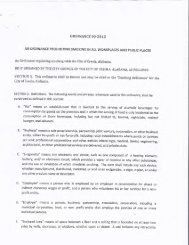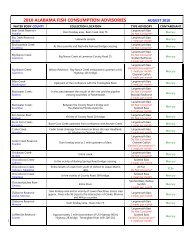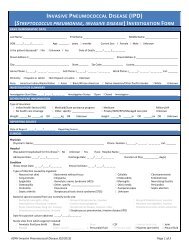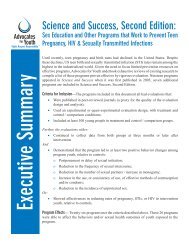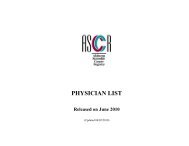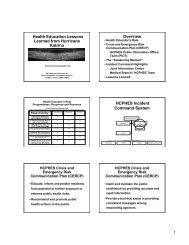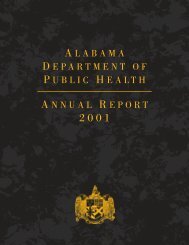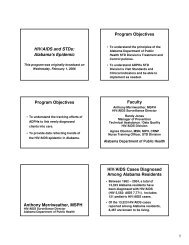2007 - Alabama Department of Public Health
2007 - Alabama Department of Public Health
2007 - Alabama Department of Public Health
You also want an ePaper? Increase the reach of your titles
YUMPU automatically turns print PDFs into web optimized ePapers that Google loves.
ureau <strong>of</strong> clinical laboratories<br />
The division continues participation in the Tuberculosis<br />
Cooperative Agreement Grant and CDC Tuberculosis<br />
Multi-Drug Resistant Susceptibility Study. Isolates from<br />
all new cases <strong>of</strong> M. tuberculosis are being sent to the<br />
regional DNA Fingerprint laboratory in Michigan for<br />
genotyping. Genotype cluster information is relayed to<br />
the Division <strong>of</strong> Tuberculosis Control.<br />
Sanitary Bacterology/Media Division<br />
The Sanitary Bacteriology/Media Division, located<br />
in the Montgomery Laboratory, tests dairy products,<br />
public and private water samples, as well as prepares<br />
the media used by both the county health departments<br />
and within the lab system. The number <strong>of</strong> both dairy<br />
and water samples tested remained relatively the same<br />
when compared to 2006. Working with the <strong>Alabama</strong><br />
<strong>Department</strong> <strong>of</strong> Environmental Management, four public<br />
water utility laboratories were inspected for compliance<br />
with state and federal regulations. The Media Section<br />
made a total <strong>of</strong> 4,295 liters <strong>of</strong> media which poured 78,051<br />
plates and 102,286 tubes. The breakdown for each<br />
division is shown in Table 3 below.<br />
TABLE 3 Liters Tubes Plates Flasks/Bottles<br />
Metabolic 19<br />
Milk and Water 455 2500 2,678<br />
TB 1,366 8,141 8,052<br />
Mycology 146 24,107 160<br />
Microbiology 1,692 67,538 36,647<br />
Birmingham Lab 603 32,472<br />
Mobile Lab 14 720<br />
Serology Division<br />
In March <strong>of</strong> <strong>2007</strong> the division began using a new, third<br />
generation human immunodeficiency virus (HIV) test<br />
that detects both HIV 1 and HIV 2 and is much more<br />
sensitive than the first generation test that we had been<br />
using. The positivity rate for the enzyme immunoassay<br />
(EIA) test went up slightly, about 0.35 percent. As a<br />
result the division ran about 10 percent more Western<br />
Blots. There was very little change in the number <strong>of</strong><br />
positive Western Blots but the number <strong>of</strong> indeterminate<br />
specimens increased significantly. No HIV 2 positive<br />
specimens were detected in <strong>2007</strong>. Overall test numbers<br />
remained steady with 107,161 specimens being tested for<br />
HIV in <strong>2007</strong>.<br />
The division participated in a syphilis methodology<br />
comparison study with Trinity BioTech comparing its<br />
EIA test for syphilis with the Venereal Disease Research<br />
Laboratory (VDRL) test that the division runs on a<br />
routine basis. Due to the increased cost <strong>of</strong> the EIA it<br />
was decided to continue with VDRL. There were 42,464<br />
specimens for syphilis tested in <strong>2007</strong> with a positivity<br />
rate <strong>of</strong> 3.2 percent.<br />
The division continued to experience relatively high<br />
positivity rates for Chlamydia trachomatis,13.1 percent,<br />
and Neisseria gonorrhea, 5.2 percent. The Serology<br />
Division tested 37,556 specimens for each condition.<br />
Quality Management Division<br />
The responsibilities <strong>of</strong> the Quality Management<br />
Division <strong>of</strong> the Bureau <strong>of</strong> Clinical Laboratories and the<br />
<strong>Alabama</strong> County <strong>Health</strong> <strong>Department</strong> Laboratory System<br />
encompass all facets <strong>of</strong> technical and non-technical<br />
functions. The division began the year with a host <strong>of</strong><br />
changes and challenges. Changes in leadership and the<br />
addition <strong>of</strong> new personnel allowed the division to pursue<br />
its mission to ensure that the policies and procedures<br />
set forth by the Clinical Laboratory Improvement<br />
Amendments standards are maintained and ultimately<br />
exceeded.<br />
The division’s functions consist <strong>of</strong> several components<br />
such as: patient test management; procedure manual<br />
development; quality control assessment <strong>of</strong> county<br />
clinics; training assessment <strong>of</strong> new and existing clinical<br />
personnel; administration and monitoring <strong>of</strong> the Bureau<br />
<strong>of</strong> Clinical Laboratories and county pr<strong>of</strong>iciency testing;<br />
test result and method validation; patient information<br />
and test relationships; personnel assessment <strong>of</strong> bureau<br />
and county employees; communication assessments;<br />
complaint investigations; assessment <strong>of</strong> safety issues and<br />
laboratory documentation issues.<br />
The highlight for the division is the debut <strong>of</strong> the new<br />
county laboratory system policies and procedure manual<br />
that was published and distributed throughout the state.<br />
34



